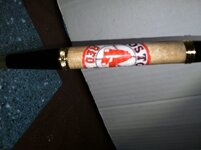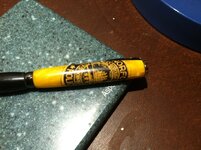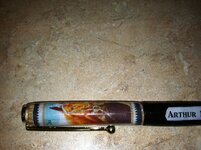Notice the pen in my previous post in this thread. See the black border? It is on all four sides. The size of the image including the black border allows for an overlap at the seam. I do not even try to make the "wallpaper" seam. Some do, I think. Anyway, after cutting the image from the label I use a Sharpie marker and mark the overlapping edge black. When overlapping be sure to keep black overlapped onto black. The edge colored black will keep the seam quite invisible. Otherwise, the white edge of the overlap will be very visible. Allow the sharpie ink to dry before applying the label to the tube and doing the CA coating."
As above, I also do Dons idea. However, it depends on the color of the background at the seam. I got 4 colored markers that I use the most of- blue, black, red, and green. I drag the long side, thats back from the tip, quickly along the seam edge so it doesn"t bleed through. You may have to experiment to get the touch to prevent the bleed or the edge will be too dark. After casting I use the clip over the seam. Works for me.
Bob





